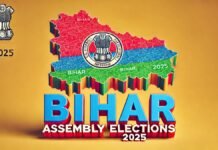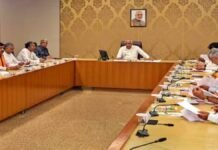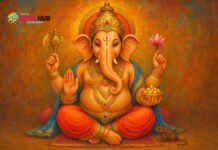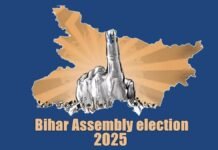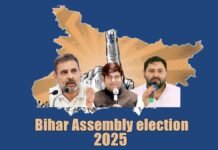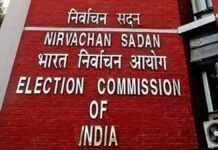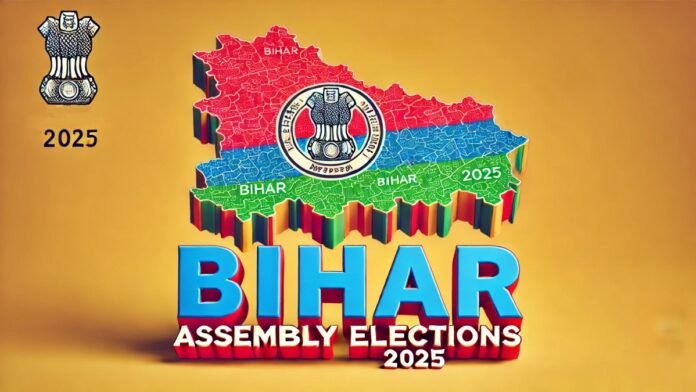
Key Points
- NDA fields 48 upper caste candidates (40% of 121 first-phase seats) vs INDI Alliance’s 23 upper caste nominees
- RJD relies heavily on MY equation with 34 Yadav and 6 Muslim candidates out of 51 seats
- NDA fields zero Muslim candidates in first phase; Grand Alliance nominates 8 Muslim candidates
- BJP-led alliance gives 21 tickets to Rajputs, while Grand Alliance bets on 11 Bhumihar candidates
- Jan Suraj makes electoral debut with focus on upper castes, fielding 20 Bhumihar candidates
- Congress attempts comeback through traditional upper caste-Muslim-Dalit coalition strategy
Patna: As Bihar gears up for the first phase of Assembly elections covering 121 constituencies, both the National Democratic Alliance (NDA) and the Grand Alliance have unveiled their social engineering strategies through candidate selection. With Diwali festivities providing the backdrop, candidates from both coalitions are intensifying their outreach efforts, and the ticket distribution reveals distinct approaches to caste mathematics that could determine electoral fortunes.
NDA’s Upper Caste Gambit
The BJP-led NDA has demonstrated overwhelming confidence in upper caste voters, allocating 48 seats nearly 40 percent of the first-phase total to candidates from forward communities. This strategic emphasis marks a clear departure from broader OBC mobilization, suggesting the alliance believes consolidating upper caste votes remains crucial to victory.
Among upper castes, Rajputs emerge as the NDA’s primary focus with 21 candidates fielded across the alliance. The BJP has nominated 12 Rajput candidates, the JD(U) has given tickets to 6, and Chirag Paswan’s Lok Janshakti Party (Ram Vilas) accounts for 2 Rajput nominees. This concentration indicates the alliance’s assessment that Rajput votes, particularly in regions with significant Kshatriya populations, will prove decisive.
Bhumihars receive the second-highest representation with 17 NDA candidates. The BJP leads with 8 Bhumihar nominees, followed by JD(U) with 6, and LJP(R) with 3. The community’s traditional influence in Bihar’s political landscape makes them a critical demographic for both alliances.
Brahmins, historically influential in Bihar politics, have been allocated 10 seats within the NDA. The BJP dominates this category with 8 Brahmin candidates, while JD(U) has fielded 2. Notably, smaller NDA partners including Jitan Ram Manjhi’s Hindustani Awam Morcha (HAM) and Upendra Kushwaha’s Rashtriya Lok Samata Party (RLSP) have not nominated any Brahmin candidates in the first phase.
The Kayastha community receives minimal representation with just one NDA ticket, allocated by the BJP.
The Muslim Candidate Vacuum
In a striking decision that has drawn criticism from opposition quarters, the NDA has fielded zero Muslim candidates in the first phase of elections. This complete absence of Muslim representation contrasts sharply with the Grand Alliance’s approach and reflects the NDA’s calculation that consolidating Hindu votes across castes outweighs minority outreach in these constituencies.
NDA’s OBC and SC Strategy
Beyond upper castes, the NDA has distributed tickets strategically among Other Backward Classes (OBC), Most Backward Classes (MBC), and Scheduled Castes (SC). The alliance has nominated 39 candidates from Backward Classes, 14 from Most Backward Classes, and 19 from Scheduled Castes.
Among OBCs, Kurmis receive the highest allocation with 13 candidates, followed by Koeris with 12, Yadavs with 8, and Paswans with 7. The Vaishya community gets 6 tickets, while Teli and Ravidas communities receive 5 each. Dhanuk and Musahar communities have 4 candidates each, Mallah gets 3, and Dhobi receives 2 seats. Single-seat allocations go to Pasi, Kalwar, and Chaurasia communities.
Grand Alliance’s Backward Class Focus
In contrast to the NDA’s upper caste emphasis, the Grand Alliance has placed maximum faith in Backward Classes, allocating 60 out of 121 seats nearly 50 percent to OBC candidates. This distribution underscores the coalition’s reliance on traditional social justice politics and Lalu Prasad Yadav’s enduring MY (Muslim-Yadav) formula.
The Rashtriya Janata Dal (RJD), as the Grand Alliance’s dominant partner, has fielded the most candidates among backward castes, nominating representatives for 40 out of 60 OBC seats. Left parties account for 3 OBC candidates, Congress has fielded 2, and the Communist Party of India contributes 1 candidate.
RJD’s MY Equation Remains Central
The RJD’s continued reliance on the Muslim-Yadav alliance formula is evident in its ticket distribution for 51 contested seats. The party has nominated 34 Yadav candidates—representing two-thirds of its total and 6 Muslim candidates. This heavy concentration reflects Lalu Yadav’s legacy strategy of consolidating these two communities as a counterweight to upper caste and other OBC coalitions.
The NDA has fielded 8 Yadav candidates across the alliance. At the same time, Congress has nominated Yadavs in 2 constituencies, suggesting both coalitions recognize the community’s electoral significance despite different approaches to courting Yadav voters.
Grand Alliance’s Muslim Outreach
Unlike the NDA’s complete absence of Muslim candidates, the Grand Alliance has fielded 8 Muslim candidates in the first phase. The RJD accounts for 6 of these nominations, Congress has given 1 ticket, and Left parties have fielded 1 Muslim candidate. This measured but visible Muslim representation aims to energize minority turnout while maintaining the MY formula’s credibility.
Beyond Yadavs and Muslims, the Grand Alliance has nominated 2 Kurmi candidates, 10 Koeris, 6 Vaishyas, and 2 candidates from the Tanti-Pan community among backward classes.
Upper Caste Balance in Grand Alliance
While focusing predominantly on backward classes, the Grand Alliance has not ignored upper caste voters, fielding candidates in 23 seats. However, this represents less than half the NDA’s upper caste allocation, indicating different priority hierarchies.
Among upper castes, the Grand Alliance places maximum trust in Bhumihars with 11 candidates. The RJD and Congress have each fielded 5 Bhumihar candidates, while Left parties contribute 1. This Bhumihar focus contrasts with the NDA’s Rajput emphasis, suggesting geographical and demographic calculations about where each community’s influence peaks.
Rajputs receive 6 Grand Alliance tickets, with the RJD nominating 5 and Left parties fielding 1. Brahmins also get 6 seats across the coalition. This relatively balanced upper caste distribution aims to prevent complete alienation of forward community voters while maintaining the alliance’s backward class core.
Scheduled Caste Representation
The Grand Alliance has nominated candidates from Scheduled Castes in 19 constituencies. Paswan and Ravidas communities dominate this category with 8 candidates each. The Musahar community, considered among the most marginalized, has received 1 ticket, while the Chamar community gets 2 nominations.
This SC focus aligns with the Grand Alliance’s broader social justice messaging and attempts to build a rainbow coalition of marginalized communities.
Congress’s Comeback Strategy
The Congress party, struggling to regain relevance in Bihar politics after years of decline, has reverted to its traditional vote bank strategy. The party is banking on its historical support base of upper castes, Muslims, and Dalits while also reaching out to backward and extremely backward classes.
By nominating candidates from diverse communities including Muslims from its quota, Congress aims to present itself as a truly secular alternative. However, the party’s reduced bargaining power within the Grand Alliance means its candidate selection reflects compromise rather than dominance.
Jan Suraj’s Electoral Debut
Political activist Prashant Kishor’s Jan Suraj party is contesting Bihar elections for the first time, and its candidate selection reveals an upper caste-focused strategy. The party has placed overwhelming trust in Bhumihars, fielding 20 candidates from this community the highest concentration of any single caste across all parties.
Additionally, Jan Suraj has nominated 9 candidates from backward castes. This distribution suggests the party is attempting to carve out space by appealing to influential landed upper castes while maintaining some OBC representation. Whether this approach can break the established NDA-Grand Alliance binary remains Bihar’s key electoral question.
Analyzing the Social Equations
The contrasting ticket distributions reflect fundamentally different theories of electoral victory. The NDA’s upper caste emphasis combined with strategic OBC allocations suggests confidence in consolidating Hindu votes across the caste spectrum, particularly by maximizing Rajput and Bhumihar turnout while ensuring key OBC communities like Kurmis and Koeris remain engaged.
The Grand Alliance’s backward class focus, especially the RJD’s heavy Yadav concentration, represents continuity with Lalu Yadav’s social justice politics. By adding measured Muslim representation and preventing complete upper caste alienation, the coalition hopes to recreate the winning formula that dominated Bihar politics in the 1990s and 2000s.
The absence of Muslim candidates in NDA’s first-phase list has already generated controversy, with opposition leaders accusing the alliance of communal politics. NDA leaders counter that candidate selection reflects winnability rather than tokenism, though this explanation has done little to address criticism.
Ground Reality and Voter Sentiment
As candidates conduct Diwali greetings and door-to-door campaigns, the effectiveness of these caste calculations will be tested against ground realities. Factors including anti-incumbency, development issues, employment concerns, and individual candidate appeal may override pure caste arithmetic in several constituencies.
Both alliances are betting that their respective formulas NDA’s upper caste plus strategic OBC approach versus Grand Alliance’s backward class plus minority focus—will deliver victory. With subsequent election phases yet to announce candidate lists, these first-phase distributions set the tone for what promises to be a closely contested battle.
The Bihar Assembly elections will ultimately reveal whether traditional caste equations retain their predictive power or whether voter priorities have evolved beyond the social engineering that has long dominated the state’s politics.
Caste-wise Candidate Distribution – Bihar Assembly Elections 2025 (First Phase)
Summary Statistics
| Category | NDA | Grand Alliance | Jan Suraj |
|---|---|---|---|
| Upper Castes | 48 (40%) | 23 (19%) | 20 (69%) |
| Backward Classes | 39 (32%) | 60 (50%) | 9 (31%) |
| Most Backward Classes | 14 (12%) | 1 (1%) | – |
| Scheduled Castes | 19 (16%) | 19 (16%) | – |
| Muslims | 0 (0%) | 8 (7%) | – |
| Others | 1 (1%) | 10 (8%) | – |



